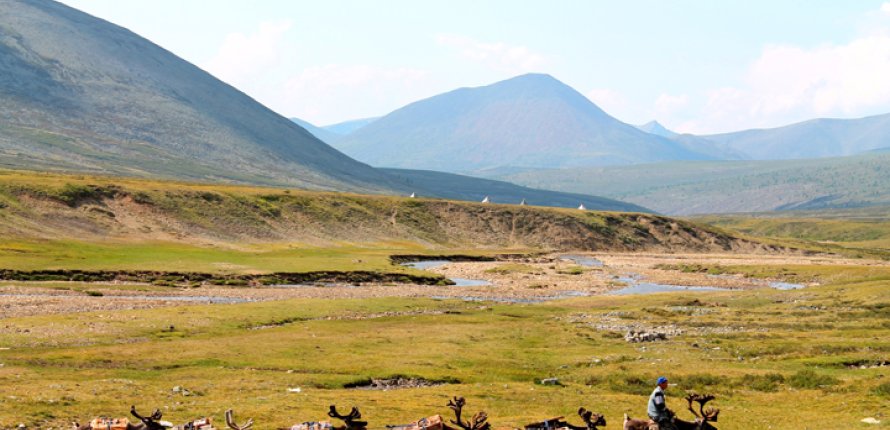The Study of Reindeer Herders in Mongolia

Todd A. Surovell, Director of Frison Institute of Anthropology at the University of Wyoming
2014-Present Fulbright Flex Scholar to Mongolia
“In the morning when the temperature is in the 20s and the stove is cold, the key is to build a hot fire early, one so hot that it cooks you out of your sleeping bag,” I wrote on the morning of September 22nd, 2014. This short passage gives a small taste of what life in a northern Mongolian taiga, with a camp of Dukha reindeer herders, is like. The Dukha move their tipi-like conical lodges and reindeer two to five times per year through the Sayan Mountains. As an archaeologist, I normally study the dead. For this project, I lived and worked with the Dukha to do “ethnoarchaeology,” the study of living peoples to develop tools for interpreting the archaeological record. My primary interest is in understanding where people do things. This interest developed from prior archaeological fieldwork.
I spent many years studying the spatial distribution of artifacts in a prehistoric archaeological site in Colorado, trying to reconstruct past lifeways. I realized it was easy to find spatial patterns, but understanding the meaning of those patterns was difficult because we have little knowledge of how people use space in nomadic contexts. Imagine yourself making a stone tool in a hide-covered tent 12,500 years ago. Where would you choose to sit? What factors would govern that decision? Understanding how people make such decisions is critical to understanding the distribution of artifacts in archaeological contexts. This experience directly influenced my decision to apply for a Fulbright Scholars grant because it would allow me to study living nomadic peoples and the spatial organization of their behaviors.
The Fulbright Scholar Program provided funding to map people in Dukha campsites as they went through their daily lives. Part of this project involved time-lapse imagery coupled with photogrammetry (mapping from photographic images) to record human locations in exterior spaces. We carefully analyzed every image in these time lapse videos to record the location of individuals, the activities performed, and the equipment used. This video is a direct illustration of that method. Using these data, we built models to explain how the Dukha choose where to do what they do. In turn, those models will provide insight into archaeological spatial patterning.
Departing the taiga, I returned to Ulaanbaatar to present lectures about my work to the Department of Anthropology at that National University of Mongolia and at the U.S. Embassy. These experiences allowed me to meet students in the department and collaborate with colleagues there. My Mongolian colleagues and I are actively developing new collaborations involving Dukha ethnohistory and Mongolian archaeology. For example, Dr. Tsetsegjargal Tseden is interested in collaborating on a Dukha ethnohistory project completed in conjunction with my work in the taiga and Dr. Erdene Mygmar and I continue to discuss the possibility of performing stable isotopic analysis on human remains from archaeological contexts in Mongolia.
These relationships will be long lasting. Upon my return to the States, I received Facebook friend requests from two Dukha friends, highlighting that although reindeer herders live a traditional lifestyle in the taiga, they are also very much part of the modern world. Our correspondence allows me to not only keep in touch, but to continue to practice my Mongolian language skills. Overall, I expect this project to make meaningful contributions to archaeological science. Since returning to the states, with my colleagues Dr. Matthew O’Brien and Ph.D. student Madeline Mackie, I have had a manuscript accepted for publication concerning the construction of stone playhouses by Dukha children, and we presented a paper on seasonal differences in the use of interior spaces of Dukha households at the Society for American Archaeology Conference in San Francisco.
Read more about the Dukha Ethnoarcheological Project.
